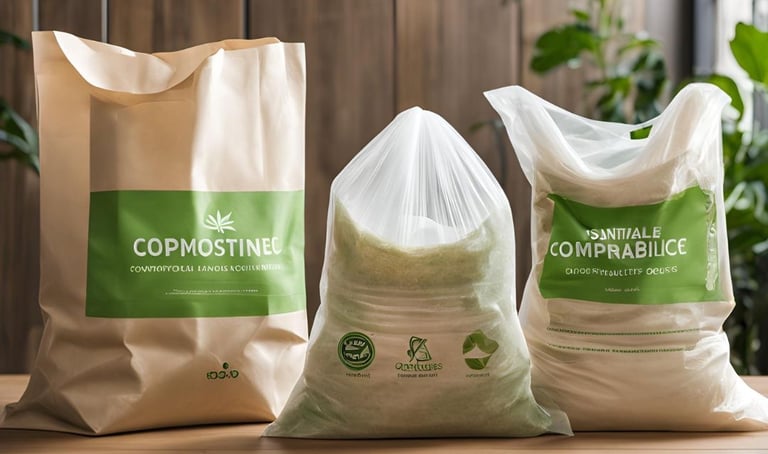The Rise of Compostable Products: A Sustainable Alternative to Plastic
As the world grapples with the environmental crisis caused by plastic pollution, compostable products have emerged as a beacon of hope. Let’s dive into how these products are made, their global production landscape, their role in a sustainable future, and their competitive edge over conventional plastics.
Nitin Sharma
3/8/20242 min read


Compostable products are primarily made from a blend of Polylactic Acid (PLA), Polybutylene Adipate Terephthalate (PBAT), starch, and fillers:
PLA (Polylactic Acid): Derived from renewable resources like corn starch or sugarcane, PLA forms the backbone of many compostable products. The fermentation of sugars produces lactic acid, which is polymerized into PLA.
PBAT (Polybutylene Adipate Terephthalate): A petroleum-based polymer, PBAT is fully compostable and adds flexibility and durability to the products.
Starch: Typically sourced from corn, potato, or cassava, starch acts as a biodegradable filler and enhances the compostability of the products.
Fillers and Additives: Organic fillers like calcium carbonate and natural fibers are added to improve product strength and reduce production costs while maintaining compostability.
The manufacturing process involves blending these raw materials, melting them at high temperatures, and shaping them into products such as carry bags, garbage bags, food packaging, and cutlery through extrusion, injection molding, or blow molding techniques.
Major Producers and Countries Leading the Charge
Compostable product production has gained significant traction globally. Some of the major contributors include:
Countries:
China: The largest producer due to its advanced manufacturing infrastructure and cost-effective production.
United States: A leader in innovation, particularly in developing advanced bioplastics like PLA.
Germany: A hub for sustainable technology, focusing on PBAT production.
India: Emerging as a key player with a focus on cost-effective starch-based compostables.
Companies:
NatureWorks (USA): A pioneer in PLA production with their Ingeo biopolymer.
Novamont (Italy): Known for their Mater-Bi, a starch-based bioplastic.
BASF (Germany): A leader in PBAT production with their Ecovio brand.
Trugro Exporters (India): Exporting a wide range of compostable products, including carry bags and medical waste bags.
How Compostable Products Support a Sustainable Future
Reducing Plastic Waste: Compostable products decompose within months in industrial composting facilities, leaving no harmful residues. This contrasts with traditional plastics, which take centuries to degrade.
Lower Carbon Footprint: The production of PLA and other compostables requires less energy and emits fewer greenhouse gases compared to conventional plastics.
Soil Enrichment: Decomposed compostable products add organic matter to the soil, improving fertility and promoting sustainable agriculture.
Support for Circular Economy: By converting renewable resources into biodegradable products, compostables align with the principles of a circular economy, reducing dependency on fossil fuels.
Future Demand for Compostable Products
The global compostable packaging market is projected to grow at a compound annual growth rate (CAGR) of 17.3%from 2023 to 2030, reflecting increasing consumer and regulatory pressure to phase out plastics. Key drivers of demand include:
Legislation: Stricter environmental regulations and plastic bans in regions like the EU, the US, and India.
Corporate Responsibility: Large corporations are pledging to adopt sustainable packaging as part of their environmental commitments.
Consumer Preference: Eco-conscious consumers are actively seeking sustainable alternatives.
Technological Innovations: Advances in bio-based materials will make compostable products more affordable and versatile.
Compostable products are more than a trend—they are a necessity for a sustainable future. By replacing traditional plastics, these products reduce environmental pollution, support soil health, and pave the way for a greener planet. As technology and awareness grow, compostables are set to become a mainstream solution, helping businesses and consumers transition to a circular economy.
MORE UPDATES ON
Home
At Trugro Exporters, we envision a world where businesses and consumers can thrive without compromising the well-being of our planet. Join us on our journey to make a positive impact—one sustainable solution at a time. Together, let’s create a future where nature and innovation flourish hand in hand.
FAQs